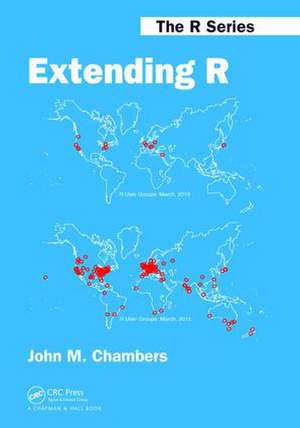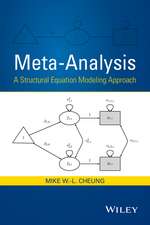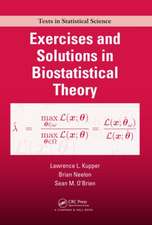Extending R: Chapman &Hall/CRC The R Series
Autor John M. Chambersen Limba Engleză Hardback – 2 oct 2017
| Toate formatele și edițiile | Preț | Express |
|---|---|---|
| Paperback (1) | 496.58 lei 6-8 săpt. | |
| CRC Press – 24 mai 2016 | 496.58 lei 6-8 săpt. | |
| Hardback (1) | 1327.47 lei 3-5 săpt. | |
| CRC Press – 2 oct 2017 | 1327.47 lei 3-5 săpt. |
Din seria Chapman &Hall/CRC The R Series
-
 Preț: 350.96 lei
Preț: 350.96 lei - 20%
 Preț: 542.93 lei
Preț: 542.93 lei - 20%
 Preț: 424.82 lei
Preț: 424.82 lei -
 Preț: 343.32 lei
Preț: 343.32 lei -
 Preț: 358.30 lei
Preț: 358.30 lei - 20%
 Preț: 548.69 lei
Preț: 548.69 lei - 8%
 Preț: 490.79 lei
Preț: 490.79 lei - 8%
 Preț: 452.19 lei
Preț: 452.19 lei -
 Preț: 400.98 lei
Preț: 400.98 lei - 8%
 Preț: 386.32 lei
Preț: 386.32 lei -
 Preț: 389.17 lei
Preț: 389.17 lei -
 Preț: 391.57 lei
Preț: 391.57 lei -
 Preț: 152.12 lei
Preț: 152.12 lei - 8%
 Preț: 512.40 lei
Preț: 512.40 lei - 20%
 Preț: 421.05 lei
Preț: 421.05 lei -
 Preț: 356.63 lei
Preț: 356.63 lei - 8%
 Preț: 418.06 lei
Preț: 418.06 lei -
 Preț: 373.05 lei
Preț: 373.05 lei - 8%
 Preț: 544.64 lei
Preț: 544.64 lei -
 Preț: 359.66 lei
Preț: 359.66 lei - 8%
 Preț: 437.61 lei
Preț: 437.61 lei -
 Preț: 358.22 lei
Preț: 358.22 lei -
 Preț: 260.53 lei
Preț: 260.53 lei - 8%
 Preț: 422.96 lei
Preț: 422.96 lei - 8%
 Preț: 438.87 lei
Preț: 438.87 lei -
 Preț: 356.63 lei
Preț: 356.63 lei - 20%
 Preț: 308.68 lei
Preț: 308.68 lei -
 Preț: 230.57 lei
Preț: 230.57 lei - 17%
 Preț: 271.58 lei
Preț: 271.58 lei - 15%
 Preț: 494.20 lei
Preț: 494.20 lei -
 Preț: 392.33 lei
Preț: 392.33 lei - 9%
 Preț: 835.78 lei
Preț: 835.78 lei - 20%
 Preț: 1329.88 lei
Preț: 1329.88 lei - 22%
 Preț: 447.69 lei
Preț: 447.69 lei - 24%
 Preț: 566.03 lei
Preț: 566.03 lei - 35%
 Preț: 842.05 lei
Preț: 842.05 lei - 18%
 Preț: 1082.45 lei
Preț: 1082.45 lei - 20%
 Preț: 578.11 lei
Preț: 578.11 lei - 26%
 Preț: 1014.74 lei
Preț: 1014.74 lei - 20%
 Preț: 1066.99 lei
Preț: 1066.99 lei - 27%
 Preț: 527.72 lei
Preț: 527.72 lei
Preț: 1327.47 lei
Preț vechi: 1723.98 lei
-23% Nou
Puncte Express: 1991
Preț estimativ în valută:
254.01€ • 265.75$ • 211.01£
254.01€ • 265.75$ • 211.01£
Carte disponibilă
Livrare economică 13-27 martie
Preluare comenzi: 021 569.72.76
Specificații
ISBN-13: 9781138469273
ISBN-10: 1138469270
Pagini: 382
Dimensiuni: 178 x 254 x 28 mm
Greutate: 0.86 kg
Ediția:1
Editura: CRC Press
Colecția Chapman and Hall/CRC
Seria Chapman &Hall/CRC The R Series
ISBN-10: 1138469270
Pagini: 382
Dimensiuni: 178 x 254 x 28 mm
Greutate: 0.86 kg
Ediția:1
Editura: CRC Press
Colecția Chapman and Hall/CRC
Seria Chapman &Hall/CRC The R Series
Cuprins
Understanding R: Objects, Functions and Interfaces. Evolution. R in Operation. Programming with R: Small, Medium and Large. Functions. Objects. Packages. In the Large. Object-Oriented Programming: Classes and Methods in R. Functional OOP in R. Encapsulated OOP in R. Interfaces: Understanding Interfaces. The XR Structure for Interfaces. An Interface to Python. An Interface to Julia. Subroutine Interfaces. Bibliography. Index.
Notă biografică
John M. Chambers is a consulting professor in the Department of Statistics at Stanford University. He previously worked at Bell Labs for 40 years, where he contributed to major research and management in statistical computing and related fields. He was the first statistician to be named a Bell Labs Fellow. Chambers is best known for the creation and extension of the S software, the predecessor to today’s very popular R. He has continued to contribute essential new directions to R. In 1999, he was honored with the ACM Software System Award, which noted that "S has forever altered the way people analyze, visualize, and manipulate data." He is a board member of the R Foundation and the R Consortium; a fellow of the ASA, the IMS, and the AAAS; and an elected member of the ISI. He is the author or co-author of nine books, including the first comprehensive book on computational methods for statistics.
Recenzii
"Chambers, a consulting professor in the Department of Statistics at Stanford University, indicates that the purpose of this book is to encourage and help individuals develop extensions to the R software. Obviously, one must have experience using R and ideas for extensions that he or she would like to make, such as adding some functions or developing packages of different degrees of sophistication. The book contains three fundamental principles: every element that exists within R is an 'object,' all elements that happen within R are a 'function' call, and 'interfaces' to other software are part of R. These principles are then expanded in sections about ideas and history, aspects of programming in R, object-oriented programming, and interfaces from R to other software. As Chambers is the creator of the S software (the predecessor of R), any of his works are considered important and should be acquired by all statistical science libraries. This book will be a valuable guide for individuals who wish to develop their own extensions to R, whether at a modest or a more ambitious level.
Summing Up: Highly recommended. Lower-division undergraduates and above; faculty and professionals."
~R. Bharath, Northern Michigan University
". . . Chambers provides valuable insight into some of the thinking that led to major contributions to R’s development. For example, one section is divided thoughtfully into three themes, namely, programming in the small, in the medium, and in the large. Each theme is used to introduce and illustrate different aspects of the language, from the point of view of the kinds of activities that cluster within the themes, and here the book really shines. It is a pleasure to see how a crafter of tools thinks deeply about how the tool will be used."
~Andrew Robinson, University of Melbourne
"Doug Bates once said to me that 'There’s no doubt about John Chambers. He can see much further than the rest of us.' This latest book is yet another illustration of that incisive observation. It is fundamentally a book about perspectives and strategies. It gives a deep insight into the R landscape, its background and structure, and shows how users can work with R when they need to extend its facilities."
~Biometrics, June 2017
"This book is a must-have for anyone with a deep interest in statistical computing . . . you will learn some of the theory that underpins R, and see the directions in which you can extend it to solve your problems . . . it does give you powerful ways of thinking about programming on a large scale that will pay off as you tackle more ambitious projects."
~Hadley Wickham, Journal of the American Statistical Association
" . . . any new book by John Chambers, the main developer of the original S language from which R derives, commands particular attention. . . Experienced R programmers will want a copy. R users seeking a deeper understanding of the internal structure of the language will also benefit, especially regarding aspects of functional programming and object-oriented computations.
~Christian Kleiber, Stat Papers
"True to the book’s name, Extending R is full of R history, scope, structure and applications. R enthusiasts will be happy to access the comprehensive wealth of information, explanations and examples all in one place. This unique book extends R with a separate section and chapters for each interface language. So, if you are a Python or Java programmer, for example, you can apply the programming tips to save you time when building applications.
In the advanced technical world of R, this book helps guide programmers to object-oriented programming principles, classes, methods, fields, functions and packages. Also included are data conversion sections to help with data and system migrations. Extending R is a reference dictionary with a glossary of terms as well as research and mathematical analysis."
~Sunil Gupta, SAS, CDISC and R Corporate Trainer and Author, Founder of R-Guru.com
"Chambers, a consulting professor in the Department of Statistics at Stanford University, indicates that the purpose of this book is to encourage and help individuals develop extensions to the R software. Obviously, one must have experience using R and ideas for extensions that he or she would like to make, such as adding some functions or developing packages of different degrees of sophistication. The book contains three fundamental principles: every element that exists within R is an 'object,' all elements that happen within R are a 'function' call, and 'interfaces' to other software are part of R. These principles are then expanded in sections about ideas and history, aspects of programming in R, object-oriented programming, and interfaces from R to other software. As Chambers is the creator of the S software (the predecessor of R), any of his works are considered important and should be acquired by all statistical science libraries. This book will be a valuable guide for individuals who wish to develop their own extensions to R, whether at a modest or a more ambitious level.
Summing Up: Highly recommended. Lower-division undergraduates and above; faculty and professionals."
~R. Bharath, Northern Michigan University
". . . Chambers provides valuable insight into some of the thinking that led to major contributions to R’s development. For example, one section is divided thoughtfully into three themes, namely, programming in the small, in the medium, and in the large. Each theme is used to introduce and illustrate different aspects of the language, from the point of view of the kinds of activities that cluster within the themes, and here the book really shines. It is a pleasure to see how a crafter of tools thinks deeply about how the tool will be used."
~Andrew Robinson, University of Melbourne
"Doug Bates once said to me that 'There’s no doubt about John Chambers. He can see much further than the rest of us.' This latest book is yet another illustration of that incisive observation. It is fundamentally a book about perspectives and strategies. It gives a deep insight into the R landscape, its background and structure, and shows how users can work with R when they need to extend its facilities."
~Biometrics, June 2017
"This book is a must-have for anyone with a deep interest in statistical computing . . . you will learn some of the theory that underpins R, and see the directions in which you can extend it to solve your problems . . . it does give you powerful ways of thinking about programming on a large scale that will pay off as you tackle more ambitious projects."
~Hadley Wickham, Journal of the American Statistical Association
" . . . any new book by John Chambers, the main developer of the original S language from which R derives, commands particular attention. . . Experienced R programmers will want a copy. R users seeking a deeper understanding of the internal structure of the language will also benefit, especially regarding aspects of functional programming and object-oriented computations.
~Christian Kleiber, Stat Papers
~R. Bharath, Northern Michigan University
". . . Chambers provides valuable insight into some of the thinking that led to major contributions to R’s development. For example, one section is divided thoughtfully into three themes, namely, programming in the small, in the medium, and in the large. Each theme is used to introduce and illustrate different aspects of the language, from the point of view of the kinds of activities that cluster within the themes, and here the book really shines. It is a pleasure to see how a crafter of tools thinks deeply about how the tool will be used."
~Andrew Robinson, University of Melbourne
"Doug Bates once said to me that 'There’s no doubt about John Chambers. He can see much further than the rest of us.' This latest book is yet another illustration of that incisive observation. It is fundamentally a book about perspectives and strategies. It gives a deep insight into the R landscape, its background and structure, and shows how users can work with R when they need to extend its facilities."
~Biometrics, June 2017
"This book is a must-have for anyone with a deep interest in statistical computing . . . you will learn some of the theory that underpins R, and see the directions in which you can extend it to solve your problems . . . it does give you powerful ways of thinking about programming on a large scale that will pay off as you tackle more ambitious projects."
~Hadley Wickham, Journal of the American Statistical Association
" . . . any new book by John Chambers, the main developer of the original S language from which R derives, commands particular attention. . . Experienced R programmers will want a copy. R users seeking a deeper understanding of the internal structure of the language will also benefit, especially regarding aspects of functional programming and object-oriented computations.
~Christian Kleiber, Stat Papers
"True to the book’s name, Extending R is full of R history, scope, structure and applications. R enthusiasts will be happy to access the comprehensive wealth of information, explanations and examples all in one place. This unique book extends R with a separate section and chapters for each interface language. So, if you are a Python or Java programmer, for example, you can apply the programming tips to save you time when building applications.
In the advanced technical world of R, this book helps guide programmers to object-oriented programming principles, classes, methods, fields, functions and packages. Also included are data conversion sections to help with data and system migrations. Extending R is a reference dictionary with a glossary of terms as well as research and mathematical analysis."
~Sunil Gupta, SAS, CDISC and R Corporate Trainer and Author, Founder of R-Guru.com
"Chambers, a consulting professor in the Department of Statistics at Stanford University, indicates that the purpose of this book is to encourage and help individuals develop extensions to the R software. Obviously, one must have experience using R and ideas for extensions that he or she would like to make, such as adding some functions or developing packages of different degrees of sophistication. The book contains three fundamental principles: every element that exists within R is an 'object,' all elements that happen within R are a 'function' call, and 'interfaces' to other software are part of R. These principles are then expanded in sections about ideas and history, aspects of programming in R, object-oriented programming, and interfaces from R to other software. As Chambers is the creator of the S software (the predecessor of R), any of his works are considered important and should be acquired by all statistical science libraries. This book will be a valuable guide for individuals who wish to develop their own extensions to R, whether at a modest or a more ambitious level.
Summing Up: Highly recommended. Lower-division undergraduates and above; faculty and professionals."
~R. Bharath, Northern Michigan University
". . . Chambers provides valuable insight into some of the thinking that led to major contributions to R’s development. For example, one section is divided thoughtfully into three themes, namely, programming in the small, in the medium, and in the large. Each theme is used to introduce and illustrate different aspects of the language, from the point of view of the kinds of activities that cluster within the themes, and here the book really shines. It is a pleasure to see how a crafter of tools thinks deeply about how the tool will be used."
~Andrew Robinson, University of Melbourne
"Doug Bates once said to me that 'There’s no doubt about John Chambers. He can see much further than the rest of us.' This latest book is yet another illustration of that incisive observation. It is fundamentally a book about perspectives and strategies. It gives a deep insight into the R landscape, its background and structure, and shows how users can work with R when they need to extend its facilities."
~Biometrics, June 2017
"This book is a must-have for anyone with a deep interest in statistical computing . . . you will learn some of the theory that underpins R, and see the directions in which you can extend it to solve your problems . . . it does give you powerful ways of thinking about programming on a large scale that will pay off as you tackle more ambitious projects."
~Hadley Wickham, Journal of the American Statistical Association
" . . . any new book by John Chambers, the main developer of the original S language from which R derives, commands particular attention. . . Experienced R programmers will want a copy. R users seeking a deeper understanding of the internal structure of the language will also benefit, especially regarding aspects of functional programming and object-oriented computations.
~Christian Kleiber, Stat Papers
Descriere
Extending R covers key concepts and techniques in R to support analysis and research projects. It provides programming guidance for projects of all scales, and introduces new, valuable techniques that extend R. and incorporates a new structure for interfaces applicable to a variety of languages.












